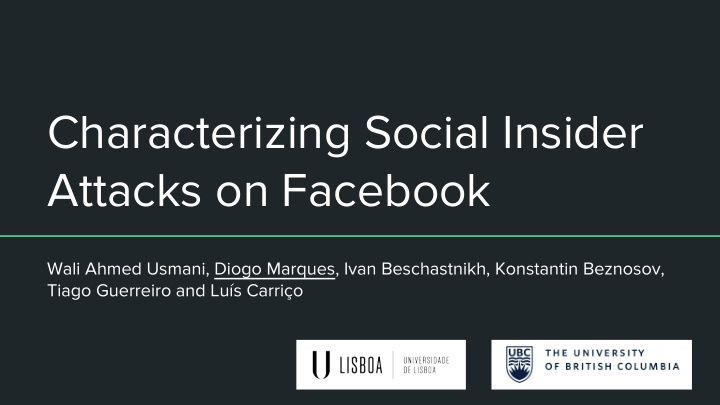



Characterizing Social Insider Attacks on Facebook Wali Ahmed Usmani, Diogo Marques, Ivan Beschastnikh, Konstantin Beznosov, Tiago Guerreiro and Luís Carriço
Social insider attacks on Facebook ● Social insider: “perpetrator” is someone in “victim’s” social circle
Social insider attacks on Facebook ● Social insider: “perpetrator” is someone in “victim’s” social circle Attack: “perpetrator” accesses “victim’s” account: ● ○ Using Facebook’s end-user interfaces (e.g. web, mobile app) ○ On the “victim’s” device ○ Without the “victim’s” permission
Research Questions ● How prevalent are social insider attacks against Facebook accounts? 3-group list experiment ○ ○ MTurk, n = 1,308 24% estimated to have been perpetrators ○ ○ 21% estimate to have been knowing victims What are the salient dimensions of social insider attacks against Facebook ● accounts? ○ Qualitative MTurk, n = 45 ○ ○ Attacks typified by motivation: fun, curiosity, jealousy, animosity, and utility Detailed narratives on before / during / after ○
Research Questions ● How prevalent are social insider attacks against Facebook accounts? 3-group list experiment ○ ○ MTurk, n = 1,308 24% estimated to have been perpetrators ○ ○ 21% estimate to have been knowing victims What are the salient dimensions of social insider attacks against Facebook ● accounts? ○ Qualitative MTurk, n = 45 ○ ○ Attacks typified by motivation: fun, curiosity, jealousy, animosity, and utility Detailed narratives on before / during / after ○
Research Questions ● How prevalent are social insider attacks against Facebook accounts? 3-group list experiment ○ ○ MTurk, n = 1,308 24% estimated to have been perpetrators ○ ○ 21% estimate to have been knowing victims What are the salient dimensions of social insider attacks against Facebook ● accounts? ○ Qualitative MTurk, n = 45 ○ ○ Attacks typified by motivation: fun, curiosity, jealousy, animosity, and utility Detailed narratives on before / during / after ○
Study 1: How prevalent are social insider attacks against Facebook accounts?
The list experiment technique Control Treatment Bananas Bananas Standing in lines Standing in lines Rainbows Rainbows Marijuana How many of these items do you love?
The list experiment technique Control Treatment Bananas Bananas Standing in lines Standing in lines Rainbows Rainbows x ̄ = 2.0 x ̄ = 2.5 Marijuana How many of these items do you love? Estimated proportion of respondents who identify with loving marijuana: (2.5 - 2.0) = 0.5
Groups Control group [...] To preserve your anonymity, select HOW MANY statements apply to you, not WHICH ONES. ● I have more than 300 friends on Facebook. ● I am friends with one of my parents on Facebook. ● I have commented or liked a post in the last month on Facebook. ● I have reported an account on Facebook. ● I have had dinner with the founder of Facebook, Mark Zuckerberg. Treatment-P group extra statement: ● I have used a device of someone I know to access their Facebook account without permission. Treatment-V group extra statement: ● Somebody I know has used my device to access my Facebook account without permission.
Results ● 1,308 valid responses Group Participants Mean Control 440 2.334 Treatment-P 423 2.574 Treatment-V 445 2.546 ● Prevalence estimates: 24.0% (SE = 0.070) perpetrators 21.2% (SE = 0.070) knowing victims
Effects of age Younger participants more likely to have perpetrated attacks. Age had little effect on the likelihood of having been a victim.
Study 2: What are the salient dimensions of social insider attacks against Facebook accounts?
Study design ● Online survey Participants asked for free-form descriptions of past incidents ● ○ Written as stories ○ Character “Casey” is the perpetrator ○ Character “Alex” is the victim
Study design ● Online survey Participants asked for free-form descriptions of past incidents ● ○ Written as stories ○ Character “Casey” is the perpetrator ○ Character “Alex” is the victim ● 45 valid stories Avg. 263 words per story ○ ○ 71 codes across 7 main themes Code saturation at 35th story ○ ○ Cohen’s kappa for last 10 stories = 0.95
Motivation ● 5 types of motivation Fun: perpetrator wanted to play a prank on the victim without a premeditated malicious intent. ○ ○ Jealousy: perpetrator wanted to know if the victim had been emotionally involved with others. Curiosity: perpetrator was curious about content on the victim’s Facebook without a ○ predetermined emotional foundation to the intent. Utility : the perpetrator was not directly interested in the victim’s account, but wanted to use it to ○ achieve a practical goal. Animosity : the perpetrator’s primary motive was to hurt the victim. ○
“While he was using the bathroom, Casey decided to just post something dumb on [Alex’s] account. She posted "I smell." She left and had a good laugh.” [From Story 4]
“After Alex was sound asleep from the alcohol that had been consumed, Casey grabbed Alex's sleeping hand and pressed a finger up to the sensor. Success! Casey checked all of Alex's personal messages for any signs of infidelity.” [From Story 10]
Motivation ● Motivation indicative of many of the dimensions of attacks, but insufficient. Variation within each type of motivation ○ ○ Cross-cutting dimensions
“ Casey could not confront Alex because there was no proof of the infidelity. [One day] Alex [found] Casey asleep on the couch with the cell phone on the coffee table…” [From Story 9]
“I didn’t have any trouble getting into the phone because, as I said, I knew the code to his and he knows the code to mine as well.“ [From Story 24]
“Alex ended the relationship sadly because their time together had been great.” [From Story 14]
“Casey has tried several times to contact Alex to explain but [Alex isn’t] willing to listen. Casey hopes that they can become best friends again someday.” [From Story 26]
Takeaways Social insider attacks on Facebook: ● Are common ● Are diverse ● Have severe consequences Are difficult to mitigate ●
Characterizing Social Insider Attacks on Facebook Wali Ahmed Usmani, Diogo Marques, Ivan Beschastnikh, Konstantin Beznosov, Tiago Guerreiro and Luís Carriço
Recommend
More recommend